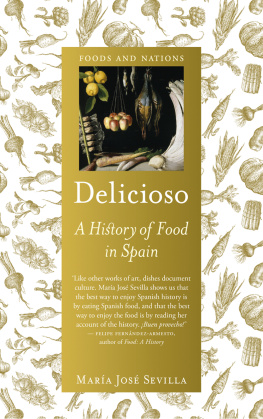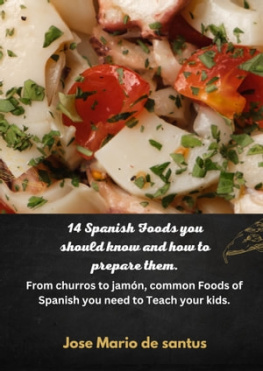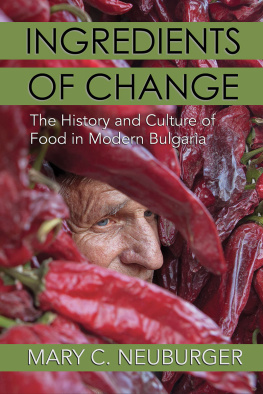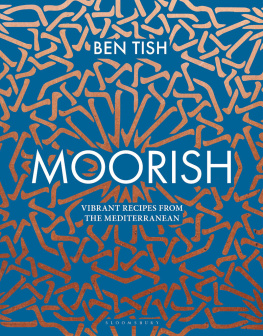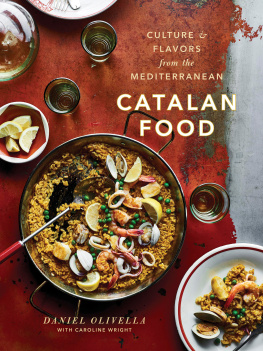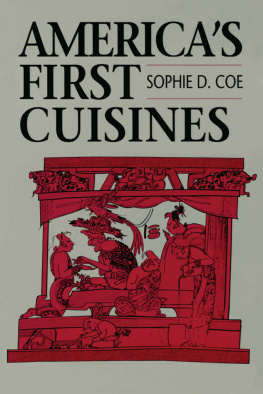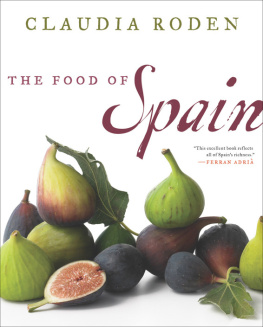DELICIOSO

FOODS AND NATIONS is a new series from Reaktion that explores the history and geography of food. Books in the series reveal the hidden history behind the food eaten today in different countries and regions of the world, telling the story of how food production and consumption developed, and how they were influenced by the culinary practices of other places and peoples. Each book in the Foods and Nations series offers fascinating insights into the distinct flavours of a country and its culture.
Already published
Al Dente: A History of Food in Italy
Fabio Parasecoli
Beyond Bratwurst: A History of Food in Germany
Ursula Heinzelmann
Delicioso: A History of Food in Spain
Mara Jos Sevilla
Feasts and Fasts: A History of Food in India
Colleen Taylor Sen
Gifts of the Gods: A History of Food in Greece
Andrew and Rachel Dalby
Rice and Baguette: A History of Food in Vietnam
Vu Hong Lien
A Rich and Fertile Land: A History of Food in America
Bruce Kraig
Delicioso

A Hisory of Food
in Spain
MARA J OS S EVILLA
REAKTION BOOKS
To my granddaughter Sofa Maria
Published by Reaktion Books Ltd
Unit 32, Waterside
4448 Wharf Road
London N1 7UX, UK
www.reaktionbooks.co.uk
First published 2019
Copyright Maria Jos Sevilla 2019
All rights reserved
No part of this publication may be reproduced, stored in a retrieval system, or transmitted, in any form or by any means, electronic, mechanical, photocopying, recording or otherwise, without the prior permission of the publishers
Page references in the Photo Acknowledgements and
Index match the printed edition of this book.
Printed and bound China by 1010 Printing International Ltd
A catalogue record for this book is available from the British Library
eISBN 9781789141894
CONTENTS

INTRODUCTION

T he history of Spanish food is a subject that has been neglected in the past by scholars. In Spain, history can be found in every corner of this diverse country. A diversity which is difficult to match in the rest of Europe opens up a world of all things Spanish: land and people, music, tradition, language and, of course, food. From early times, Spanish food has been enriched by the different cultures that arrived in the area where the Basques and Iberians, believed by some historians to have been the original inhabitants of the peninsula, were already living. Cereals and peas moving westwards across the Mediterranean began feeding Iberians along the Mediterranean and southern Atlantic coast and Celts in the north and northwest of the peninsula, where they would settle to raise animals and cultivate the land. From the other side of the Mediterranean came the Phoenicians. They were looking for trade, valuable minerals and, in particular, sea salt to cure fish. The Greeks brought wine to Catalonia, while the Romans looked to Hispania for olive oil, garum, grain and gold. Before the arrival of the Romans, the Jews had already taken refuge in Sepharad, the name they gave to the Iberian Peninsula.
Then, in the fifth century, Germanic tribes crossed the Pyrenees to occupy the remains of what had been the Roman province. Later, Berbers and Arabs would make their home here for almost eight centuries, converting most of the peninsula into a fertile garden of beauty they called Al-Andalus. During the thirteenth and fourteenth centuries, before the Christian Reconquista of the land had ended in Castile, expansion of the powerful federation of Aragon, Catalonia and Valencia in the Mediterranean added another layer of flavour and tradition to the food of Iberia one which was greatly influenced by Italy. From the sixteenth century onwards, exchanges of food with America expanded Spains larder of ingredients and improved the interest and variety of its food. The arrival of the Bourbons in the early eighteenth century, and the resulting French influence on Spanish life and food, provoked a strong negative reaction in the population.
By the nineteenth century, Spanish authors and restaurant critics had become defenders of the authentic food of Spain. Threatened by the loss of identity, they strongly guarded the concept of a national cuisine which in reality had never existed before. However, it might have been better if they had just championed the regional cocinas, or cuisines, of Spain, which had been under threat for quite some time: Las Cocinas de las Autonomas de Espaa (The Cuisines of the Autonomous Communities of Spain), as they should correctly be called today. The loss of Cuba and the Philippines in 1898 was a major blow to the pride of Spaniards and the economy of the country, but the years of hunger and deprivation and the terrible experiences of civil war in the 1930s seriously affected agriculture and the cocinas.
Writing a comprehensive book about the history of Spanish food has been a challenge. I am a Spanish food writer who lives abroad, fascinated by my own country and my culture, and who has found in social history an answer to the way I cook and like to eat. For the last thirty years, this fascination has created in me an attachment to the subject of Spanish food and wine that, in the way of those in exile (voluntary in my case), has grown stronger through living outside the land of my birth. Sharing Spanish food and wine with others, travelling, cooking and writing books on the subject have helped me along the way and allowed me to keep in touch with my origins at a time when food has been changing dramatically in Spain.
When I left Spain in 1971, Francos dictatorship was ending, and the road to democracy and favourable economic prospects was already under construction. Only a few years before, J. H. Elliott, the prestigious British historian, had written the following words in an early edition of his book Imperial Spain:
A dry, barren, impoverished land: 10 per cent of its soil bare rock; 35 per cent poor and unproductive; 45 per cent moderately fertile, 10 per cent rich. A peninsula separated from the continent of Europe by the mountain barrier of the Pyrenees isolated and remote. A country divided within itself, broken by a high central tableland that stretches from the Pyrenees to the southern coast. No natural centre, no easy routes. Fragmented, disparate, a complex of different races, languages, and civilizations this was, and is Spain.
Although things have improved dramatically since the 1970s, some of Elliotts remarks may perhaps remain relevant forever. His words not only describe the fabric of the country but its uniqueness and strong, complex personality. Now more than ever, the necessary acceptance of the plurality of Spain, trying at the same time to effect syncretism, convergence and divergence in society, will also contribute to an understanding of the individual personality of the countrys food.
Todays Spain is largely a modern country where motorways and fast trains cross the dramatic landscape much admired by poets and painters. Left behind, hopefully for good, is the chronic backwardness of the rural areas that affected the country badly, a malady which for centuries rendered the life of the Spanish farmer, and a large part of society, impossible.

